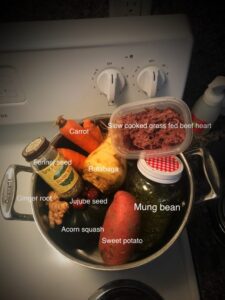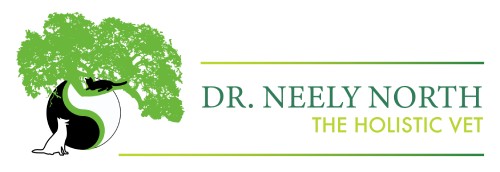“Let food be thy medicine and medicine be thy food”
Hippocrates, The Father of Medicine, c. 400 BC

Traditional Chinese Veterinary Medicine has 4 branches: Acupuncture, Herbal medicine, Tui-nai (Chinese massage) and Food Therapy. I received a certification in food therapy in 2014 and have been using food as medicine ever since. This is not meant to replace medicine, acupuncture, and herbs but is used as a compliment to the overall care of the pet. After all, we are what we eat, right?
This is a very specific meal made for a specific patient. I cannot make dietary recommendations that go for all pets in a blog post. However, if you are interested in learning to cook for your pet, what foods would be best for their conditions/ constitutions, please contact me at Savannah Holistic Veterinary Care (see contact section of website).
This recipe is for a pet with a qi, blood and yin deficiency with some severe stagnation. Stagnation is a term we use for blockage of energy. Yin deficiency is most easily understood as those pets that are really hot all of the time (think hot flashes in menopausal aged women- this is a yin deficiency). Blood deficiency is somewhat different than a diagnosis of anemia in traditional medicine. It is more of a concept that the blood carries energy along the meridians. To further explain why this diet isn’t just for any pet with these problems, Zurich was not strong enough for this diet when he first came to me. We had to strengthen his spleen qi deficiency with acupuncture and herbs before he could use the ingredients listed below and that took about 3 weeks.
He had pale lips and tongue, deep cracks in the tongue, panted heavily even in a 70 degree home and takes up to an hour to cool off after a short jaunt outside. There were a few flakes on the skin and his paw pads are cracked. His pulses were weak in general but much weaker on the left (the blood pulse). He was weak in his rear limbs an possibly has some arthritis pain in his hips. He was a giant breed dog (Bernese Mountain Dog) with lymphoma (terminal cancer).
In Traditional Chinese Veterinary Medicine Food Therapy, all foods have temperatures and a tonic property. I will list each food below with it’s temperature, tonic property and one other nutritional fact:
1. Mung Bean: cooling thermal nature, detoxifies the body, yin tonic/ builds the yin fluids, can be used to treat stomach ulcers (ex. pet is on prednisone chronically for the lymphoma and has occasional tarry stools). I purchased these at the Asia Market on Montgomery Crossroads (shop local people!). These were rinsed and soaked overnight then slow cooked for 2 hours.
2. Carrot: if you’ve ever researched what food to eat if you have cancer, you will find carrot is the most common answer. I try to get his from the farmers market so they are locally grown/ organic. Root veggies absorb a lot from the soil so it is one of the vegetables I think is important to use organic sources. Carrot has a neutral thermal nature and they can be too sweet in large amounts (as you see three carrots for about 3 days worth of food here). Peeled chopped slow cooked 2-3 hours.
3. Ginger root: technically warming in nature but it is a strong food fr resolving stagnation. I used about 2 tsp of grated ginger in this recipe. We all know it can soothe the stomach but ginger can also aid in breaking down of meats and beans. This is organic, from Whole Foods. Added at the end of cooking when the heat was turned off.
4. Grass Fed Organic Beef Heart from Hunter Farms: Warming nature but chosen because it’s one of the strongest blood tonic foods around. It is also borderline irresistible to most dogs and this pet has had a decreased appetite due to cancer. Organ meat has so many / very strong medicinal benefits. It is only meant to be fed in small amounts, it’s too rich for most pets as a primary meat source. This was previously slow cooked on very low heat and pureed to make it easier to digest/ mix evenly with the rest of his food.
5. Fennel seed: “The great mover of the Qi” (qi pronounced “Chee”= life energy). This is warming and has a strong flavor so I only added 2 tsp. It aids in reducing gas that can be caused from fiber/ beans/ veggies as well as moving his energy through his body. Because of the strong flavor, a few weeks ago I actually made a separate tea and added it to a meal to see if he was ok with the taste before putting in an entire batch. He liked it. My dogs on the other hand do not like it much. It depends!
6. Rutabaga: neutral thermal nature builds the blood, moves the qi, improves appetite, good source of sulfur. This pet really likes the taste of Rutabaga from previous recipes.
7. Sweet potato: Cooling thermal nature, strengthens digestion, removes toxins, rich in Vitamin A. Note there is only 1 sweet potato in a recipe for about 3 days of food. Too much sweet potato can have the opposite effects on digestion. Old, deficient pets need it peeled and cooked slow and low to be able to digest it properly.
8. Acorn Squash: warming thermal nature, impulse buy- I usually try to include something that is very seasonal in each recipe. This improves qi circulation and alleviates pain; high in vitamin A (cancer) Only 1/2 of it included in the recipe, no seeds.
9. Jujube seed (Chinese date, dried herb): Jujube also known as Hong Zao when used as an herb is a rich blood tonic that should only be used in small amounts. It is known to calm the mind and promote rest. This patient was waking at night, seemed anxious and hot at night. We added jujube and a floor fan, this along with acupuncture led to him sleeping through the night.
Not pictured:
1.Two pounds of 85/15 ground turkey, browned separately. Cooling thermal nature, good choice of protein when digestion is weak. I added Extra protein as many sources say cancer patients should eat higher protein diets.
2.Barley: cooling thermal nature, yin tonic, Soaked overnight, cooked on low heat with mung beans for about 2-3 hours.
3. Asparagus: cooling thermal nature, added a few spears towards the end of cooking. I was also feeding some of this to my own pet who needed some asparagus for her bladder.
**All foods were combined in the water they were cooked in and blended together as a puree. Served with a digestive enzyme, at room temperature and added to his ration of The Honest Kitchen food he gets for the day. Cancer patients often have finicky appetites so I asked the client to have some boiled egg, canned salmon and sardine around so that he could change the taste of the food if he decided he didn’t want it one day (a common problem with end stage cancer patients).
This is not an exact recipe and I didn’t include all portions/ ratios. It is possible to get a nutritionist involved and formulate a totally home cooked diet that is balanced / proper to feed for life. I choose to use food therapy as an addition the a commercially prepared food (By The Honest Kitchen).
In addition to food therapy, this patient was on Stasis Breaker and Wei Qi Booster from Jing Tang Herbal and received weekly acupuncture in the comfort of his own home.
For more information on a TCVM diagnosis for your pet and accompanying food therapy, contact Savannah Holistic Veterinary Care today.
References
Chi Institute food therapy course materials 2014
Healing with Whole Foods Paul Pitchford
Chi Institute Basic and Advanced course materials 2013, 2015
Sources for ingredients:
Whole Foods, Savannah
Forsyth Farmers Market
Tybee Farmers Market
Hunter Cattle Brooklet, GA
Asia Market Montgomery Crossroads, Savannah

